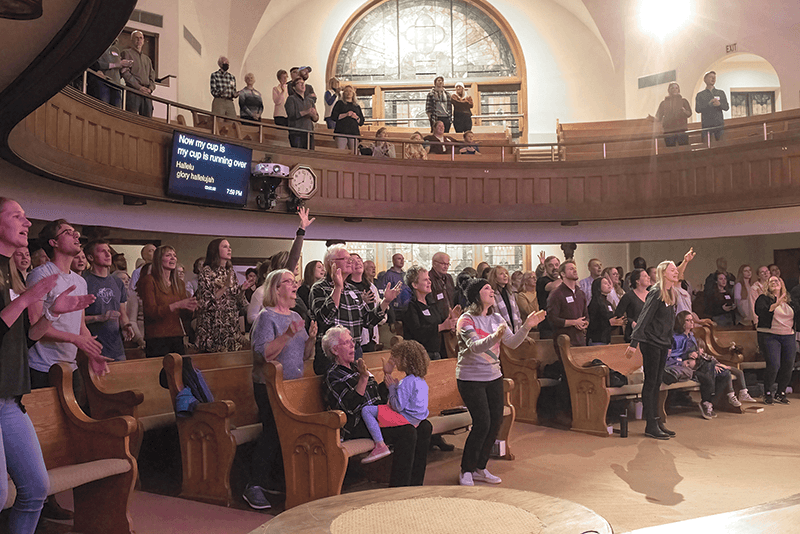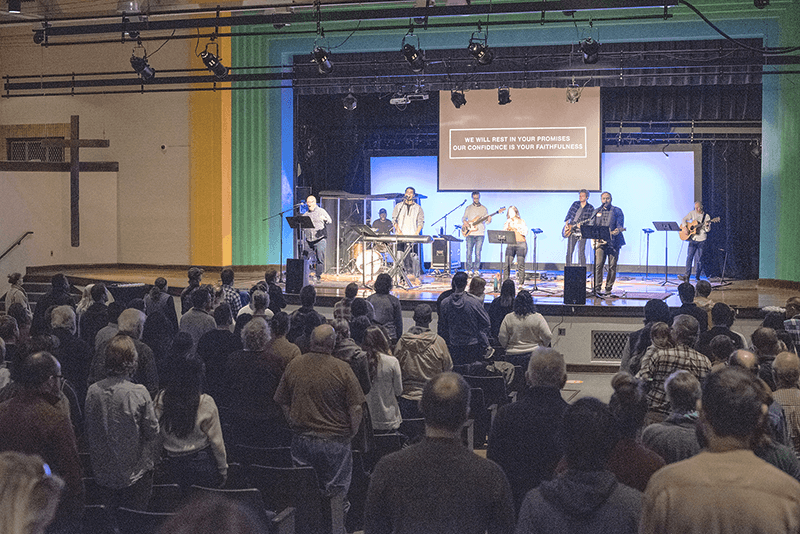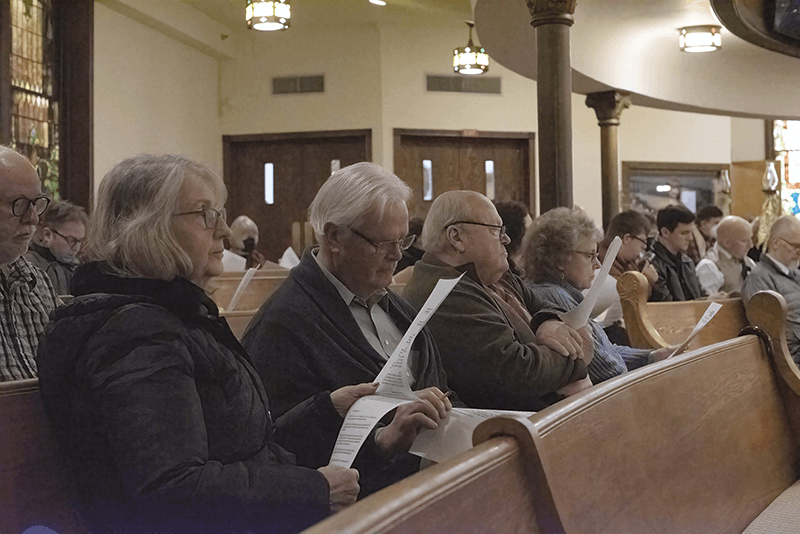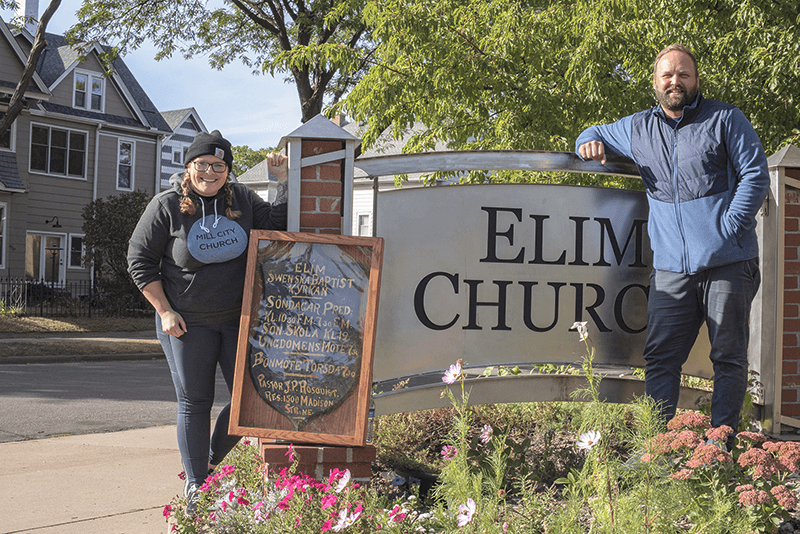“Dissolution” was the word that really got to Elim Church’s Pastor Becky Hanson, she said, wiping away tears and her voice breaking, as she spoke from a pew to church members in a business meeting in the sanctuary after their Sunday service on Dec. 18. “I love this church,” Hanson said, and asked Lead Pastor Paul Olson to pray over those assembled and those listening on Zoom.
Troy Lubbers, a member of Elim’s leadership team, had just read two multipage motions, full of legalese, in preparation for voting. Church members were given copies to read along. If passed, the motions would result in the transfer of all of Elim’s assets to Mill City Church. The nearly 135-year-old Elim Church, as a legal entity, would no longer exist. Its members would still worship in the Elim building, with Mill City’s congregation, and the church would bear the Mill City name.
A half-mile away, in the cafeteria of Las Estrellas (formerly Sheridan) School, one of the spaces in the school they rent on Sundays, Mill City Church members also were voting. For them, the question was whether their 14-year-old church was ready to take on the fiscal and spiritual stewardship of Elim’s building and congregation and to anchor themselves in a permanent, more traditional worship space.
Better together?
The decision day was the culmination of more than eight months of thorough vetting of the “Better Together” proposal, the name borrowed from the title of a book on best practices in church mergers. The idea initially was brought to Mill City’s Lead Pastor Stephanie O’Brien in the spring by Elim’s Lead Pastor Paul Olson, spurred by discussions with Elim’s leadership team.
Olson said when he first became pastor five years ago, he realized that despite an active ministry, particularly with respect to serving the homeless, within a few years “something was going to need to shift or change.” He said that attendance had been declining about 5% every year since 2000. “I began just thinking and praying and preparing,” Olson said.
Then the COVID pandemic hit, the sanctuary became even emptier, and he and the leadership team discussed options. Was it time for a new pastor? They agreed that wasn’t the answer; an even bigger shift was needed.
“We’ve always had it in our hearts to have the building more used with more people, and to be able to have more outreach into the community,” said Leslie Smith, chair of Elim’s leadership team, in October. “Now, we just can’t sustain all of that, either with volunteers or with energy and time. So far we’ve managed it with finances. We’ve got some very generous people, but it’s not thriving in the way that we really have a vision for.”
O’Brien brought Olson’s proposal to the Mill City leadership team, and both teams considered it over the course of the summer, then met together Sept. 6 to carefully plan how to involve their congregations in the decisions that might lead to what they called an “adoption merger.” After studying the dynamics of successful church mergers, they decided it was best for the 14-year-old Mill City, a growing church with a younger congregation, to take the reins.
“Mill City would be adopting this 135-year-old legacy. And that means Elim receives a future and a future with momentum. Both the legacy and the future matter,” said O’Brien in a joint interview with Olson, a few days after the possibility was announced to the congregations.
Elim’s legacy
Elim goes back to the late 1800s when six Swedish women in Northeast Minneapolis who had started a sewing society four years earlier raised funds for a church where they could worship in their native language. In 1888, 55 charter members founded Elim Swedish Baptist church, meeting in a rented space at what is now Central Ave. and 23rd Ave. NE.
The growing congregation moved several times and in 1896 bought Grace Baptist Church on the corner of 13th Avenue and Madison Street NE, where the current church stands. In 1905 that church was replaced with a new building; a Minneapolis Journal account announcing the new construction and dedication said that the church “has become one of the strong and influential churches in Northeast Minneapolis.”
In 1913 the church celebrated its 25th anniversary with a membership of 550. Reverend V. E. Hedberg, who had overseen the new building in 1905, had been the pastor for 13 years. Eventually they stopped holding services in Swedish and dropped the “Swedish” from its name. Construction in 1961 added the A. J. Wingblade Christian Center, named after the Sunday School superintendent who had served for 50 years, and that year they added a preschool. In 1988 as the church celebrated its centennial, the congregation numbered 500, and they dedicated another addition to the north side of the church and refurbished the sanctuary and Wingblade center.
Outreach to the homeless has been a focus of the church for more than 30 years. In 1983 the church ran a transitional housing program meant to guide people from the streets into more permanent homes; that continued for 30 years, and in 2003 they started Hope Avenue, at first bringing ministry onto the streets, and then shifting to bringing people from the streets into the church, for meals and, if they chose, worshiping with the church community, clothing, showers and other resources on Sundays. They also ran a cold weather emergency shelter when temperatures were below -12 degrees F. Hope Avenue has moved to Logan Avenue in North Minneapolis, providing a men’s shelter and other homeless ministries; Pastor Becky Hanson directs those operations and is half-time at Elim; the clothing ministries continue at Elim.
Adjusting to the idea
Janet Wilson has been at Elim for 67 years, almost half of its existence. She currently runs one of the church’s clothing initiatives, The Unlimited, where women can shop for free clothing. When Wilson first heard about the adoption proposal, she was very sad, she said, but as she listened to the reasoning behind it, she adjusted her thinking. “I can’t be sad anymore, because it’s probably going to have to happen, because we are losing members … You can’t run a church without people.”
“We’ve had ups and downs with pastors. And then the music changed. And we went through all that. And we all stuck together, and we managed it and got through it all, you know,” Wilson said.
Her late husband, Gary Wilson, was a custodian at the church, a beloved volunteer coach in Northeast Minneapolis and the director of Youth Center at the church in the 1970s. Naudeanne St. Hilaire, who grew up four blocks away from the church and worked at the Youth Center, remembers evenings in which more than 200 young people from the neighborhood gathered at the center to play in the gym, play pool or ping-pong, enjoy movies and snacks. Her Catholic friends spent more time there than at their own churches, she said. She said when her children were young, the church would serve family meals once a week. “This place was just packed. And that’s what I miss, the energy of the kids, so it’ll be a lot of fun getting the building populated again,” she said in late November.
Retired pastor Randy Somody, who served as youth pastor at Elim in the 1980s when a seminarian, and who returned to Elim as a member after pastoral stints on the East Coast, said he remembers that one Sunday when he was preaching, he talked about the attitude of the older members of the congregation. “I talked about how the people at Elim could look back and see the wonderful things that the Lord had done and that they had experienced as a church, but also that they weren’t stuck in the past. They seemed to have a forward perspective.”
Having advised churches involved in mergers during his pastoral career, Somody said he was impressed with the way Mill City and Elim approached the joining, providing plenty of opportunities for feedback and questions, and for the two congregations to worship and socialize together. He commended O’Brien for reaching out to the older members of Elim’s congregation so they could get to know her through discussions and prayer times in addition to the scheduled joint worship times for all congregants.
O’Brien preached Oct. 16 at Elim, and then a worship service was held that evening – an hourlong session of praise songs led by Mill City musicians with electronic instruments and driving rhythms, sung by a full sanctuary of Elim and Mill City worshipers, who followed along with the lyrics on a screen.
The worshipers stood, some lifting their arms upward, with many of the older attendees – as well as a few younger ones – eventually sitting down as the service went on, but most still singing. At the end, everyone joined in an a cappella rendition of “Praise God to Whom All Blessings Flow.” Longtime Elim member Rod Tyberg said he found it “tremendous.” The rest of the “singspiration,” as he called it, was a little loud for him, he said, but “every service doesn’t need to be for everyone,” he said.
Other Elim members said they were excited by the energy and glad to see so many people. Several offered their thoughts, all positive, about O’Brien’s sermon that morning. “She was really reaching out to Elim,” said Tyberg. “I really enjoyed hearing Stephanie speak,” Janet Wilson said. “She’s a fantastic preacher.”
On Sunday, Nov. 6, Elim joined the Mill City folks at Las Estrellas, filling the auditorium. During the community time during the service, worshipers are encouraged to not only greet each other, but to discuss in small groups a question posed. That day it was “What is a skill you’re grateful you have?” In her sermon, O’Brien talked about the community service legacy of Elim and encouraged everyone to use their gifts as they reflected on and prayed about the possible merger.
By the time everyone filed out at the end of the service, there was standing room only and a din of chatter as the two groups socialized over cider and doughnuts in the cafeteria. As she stood observing the wide range of people in the room, Brenda Anderson from Elim said she was excited about the prospect of having a congregation with more children of her own kids’ ages.
Similar practices, different approaches
The two churches are cut from the same cloth, both members of the North Central chapter of the Converge denomination (formerly the Baptist General Conference, which has Swedish Baptist roots). There are also strong roots at Bethel University: Both lead pastors are graduates and Elim Church was involved in founding the university.
A study that the two leadership teams undertook in early fall to determine whether the merger was feasible outlined many similarities in the Sunday services, and family, youth and Christian education programming, identifying one of the biggest challenges as paring down/merging the many groups that meet within each church – Bible studies, interest groups, small neighborhood-based social groups. The team didn’t find any points of conflict or major difference in practice; they highlighted the shared values of putting scripture in the context of today’s world and being active in serving the city and communities.
Harley Schreck, a professor emeritus of anthropology at Bethel who is on the leadership team at Elim, contrasted the two church’s approaches to community involvement, with Elim’s programs such as the preschool and Hope Avenue, as being more church-based whereas Mill City’s model is more about going out into the neighborhood and partnering with organizations there, such as the Every Meal program that Mill City founded when the church learned about the food needs of Sheridan School students when school wasn’t in session. The church also encourages members who don’t live in Northeast to find ways to serve their own communities, Shreck said. “In many ways, I think the church needs to get out of the building and get involved in the neighborhood and be real intentional about that.”
He also said he would welcome the influx of younger church members that Mill City would bring. “The average age of Elim is in the 50s and Mill City is in the low 30s, and I think that’s good.” Some of his research had been on aging in Northeast neighborhoods, and he discovered that there were too few connections between long-term residents and new, younger residents. “The whole idea of intergenerational church is very exciting to me, and I think it’s needed,” Schreck said.
The Mill City perspective
Mill City Church began in 2008, a church “plant” of Woodridge Church in Medina, with a founding question of “What is God doing in Northeast Minneapolis and how can we be part of that?” according to a Mill City video about the church’s origins and practices. In a conversation with pastors O’Brien and Olson, they talked about how both churches were founded out of a desire to have services in a native language. In Mill City’s case, O’Brien said, it was, in part, the language of millennials and Gen-Xers. “Why start a new church? Well, there’s a new way of talking about Jesus that we think is going to resonate with our generation. That was part of it.”
Olson, 43, talked about how his congregation needed time to process the idea of handing the assets and the building over to a younger generation, and O’Brien, 39, added, laughing, “It’s like giving the keys over to the teenagers.”
Cathy Bergland, chair of Mill City’s leadership team, said the church hadn’t been looking for a permanent home, but being displaced from Sheridan School a couple of times in the last few years helped loosen a little their attachment to their place of worship. “The church, in our case, is broader than a building. … Whether it’s at 1201 University Avenue, or it’s online, or it’s at Quincy Hall, or at the Elim church location there on 13th and Madison, it’s more about who we are as a group of people and living out what God’s called us to do.”
Some Mill City members’ concerns about the adoption had to do with the Elim church worship space, said Owen Boldt, a Mill City member. “Mill City has done a better job than most faith organizations of bringing in people who have been hurt by the church. When you meet in a school you don’t have some of those church symbols or icons. You don’t have that same church feeling that I think people walked away from.” Walking into Elim, Boldt said, “that all comes back.”
On a very practical side, Boldt said they have done a lot of contemplating “to understand what goes into buying or being given a building of that size of that age of that complexity.” Also, having a permanent worship space will mean no longer having to set up and take down every Sunday – the music equipment, the signage, and all the materials for the four children’s rooms. “After 14 years, you say, ‘Do you want to spend even another five or 10 years unpacking everything on Sunday morning?’” said Bergland.
Many Mill City members had concerns about how to best respect and care for the Elim congregation. Mill City member Mitch Rheaume spoke to this: “As churches, we view each other as like part of the same family, the same story that God has been telling in Northeast. I think one of the biggest concerns we have is if Elim weren’t going to feel honored and celebrated through it. And if they weren’t going to feel like it was a continuation of the legacy and who they are, then it probably wouldn’t have interest to us. Because that relationship is too important.”
The vote
Before the motions were read in the Elim sanctuary, Brian Turnquist recounted the pathway that led them to this point, from the letter the leadership team sent before Better Together was considered, outlining the state of the church. He also shared more recent news that addressed a big concern of many, the role that pastors Olson and Hanson would have. They would join the Mill City staff, Turnquist said.
After the motions were read, Janet Wilson stood and addressed the members. “I’m not sure, but I think I’ve been here the longest of this congregation. It’s been a wonderful place to be. I’ve also seen how over the past few years we’ve struggled with a lot of things, and that has touched my heart.” She said her son asked her why she goes to Elim, and her response was, “‘I go because I love the Lord and I serve the Lord there and he serves me.’ I prayed that that’s what we are all thinking, that we could still be here in this beautiful building. And then we can serve God together.”
Church member Matt Knutson asked for the microphone. “I just wanted to say that wherever we, as a family, end up in six months, I want to be with you all, every single one of you.”
Then Smith announced that Mill City had finished voting and called in with their results. “We want you to know that they want to do this,” she said. Many applauded after she shared, with her voice breaking, that 95% of Mill City voters were in favor of merging.
After the Elim members’ paper ballots were collected, all the phone calls in the voting queue from those participating online were recorded and all the votes tallied, 84 of 90 Elim members – out of a total 112 – had voted to dissolve their church. “This has required courage and much discernment,” Smith said.
There were more tears and hugs in the church, as well as smiles. Then Smith shared next steps. Jan. 8 would be the last service as Elim Church. Jan. 15, all would worship at Las Estrellas for several months while repairs and “deferred maintenance” – replacing the carpet, work on the pews, patching cracks and other sprucing up – would be done on the building, with Easter as the target for the combined congregation to return to the church. Information about transferring their Elim membership to Mill City, if they wished to do so – and Smith said she hoped that would be the case – would soon be forthcoming.
Member Joyce DeHaan requested that before they leave, they sing “Amazing Grace,” and they did, some people wiping away tears.
Overheard as one man put his arm over another’s shoulder as they walked side by side on their way out of the sanctuary: “It’s been a rough couple of weeks. But I’m excited to see the direction this takes us.”
Mill City Church led an energetic hour of praise songs during a joint worship service at Elim church on Oct. 16. Elim members read the motions on dissolution before voting on Dec. 18. The Elim congregation joined Mill City Church for a Sunday Service on Nov. 6 in the auditorium at Las Estrellas, where Mill City has been meeting for 14 years. Elim’s Lead Pastor Paul Olson, front right, joined the Mill City musicians with his guitar. Mill City Lead Pastor Stephanie O’Brien held an Elim sign from the 1890s, and stood with Elim Lead Pastor Paul Olson, after a joint interview in September 2022. (Photos by Karen Kraco)



